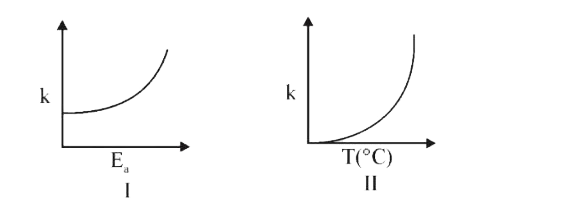The correct expression for Arrhenius equation is (where K is rate constant)
K=e−ΔH/RTA
In K=ΔEaRT+lnA
In K=ln A+EaRT
In (AK)=EaRT
The correct Answer is:D
To derive the correct expression for the Arrhenius equation, we start with the fundamental form of the equation and manipulate it step by step.
1. Start with the Arrhenius Equation:
The Arrhenius equation is given by:
k=Ae−EaRT
where:
- k = rate constant
- A = pre-exponential factor
- Ea = activation energy
- R = universal gas constant
- T = temperature in Kelvin
2. Take the Natural Logarithm of Both Sides:
To linearize the equation, we take the natural logarithm (ln) of both sides:
lnk=lnA−EaRT
3. Rearranging the Equation:
We can rearrange the equation to express lnA:
lnA=lnk+EaRT
4. Expressing in Terms of a Ratio:
From the equation lnk=lnA−EaRT, we can express it in terms of a ratio:
ln(Ak)=EaRT
5. Final Form:
Thus, the final expression derived from the Arrhenius equation is:
lnA−lnk=EaRT
or equivalently,
ln(Ak)=EaRT
6. Identifying the Correct Option:
After deriving the above expressions, we compare them with the options provided in the question. The correct expression for the Arrhenius equation is:
lnk=lnA−EaRT
The Arrhenius equation is given by:
k=Ae−EaRT
where:
- k = rate constant
- A = pre-exponential factor
- Ea = activation energy
- R = universal gas constant
- T = temperature in Kelvin
To linearize the equation, we take the natural logarithm (ln) of both sides:
lnk=lnA−EaRT
We can rearrange the equation to express lnA:
lnA=lnk+EaRT
From the equation lnk=lnA−EaRT, we can express it in terms of a ratio:
ln(Ak)=EaRT
Thus, the final expression derived from the Arrhenius equation is:
lnA−lnk=EaRT
or equivalently,
ln(Ak)=EaRT
After deriving the above expressions, we compare them with the options provided in the question. The correct expression for the Arrhenius equation is:
lnk=lnA−EaRT
Topper's Solved these Questions
- CHEMICAL KINETICSBOOK - AAKASH INSTITUTE ENGLISHCHAPTER - CHEMICAL KINETICSEXERCISE - ASSIGNMENT (SECTION A : Objective Type Questions)
50 Videos
- CHEMICAL KINETICSBOOK - AAKASH INSTITUTE ENGLISHCHAPTER - CHEMICAL KINETICSEXERCISE - ASSIGNMENT (SECTION B : Objective Type Questions)
20 Videos
- CHEMICAL KINETICSBOOK - AAKASH INSTITUTE ENGLISHCHAPTER - CHEMICAL KINETICSEXERCISE - Try Yourself
10 Videos
- CHEMICAL BONDING AND MOLECULAR STRUCTURE BOOK - AAKASH INSTITUTE ENGLISHCHAPTER - CHEMICAL BONDING AND MOLECULAR STRUCTURE EXERCISE - Assignment Section J (Aakash Challengers Questions)
10 Videos
- CHEMISTRY IN EVERYDAY LIFE BOOK - AAKASH INSTITUTE ENGLISHCHAPTER - CHEMISTRY IN EVERYDAY LIFE EXERCISE - Assignment ( SECTION - A)
45 Videos
Similar Questions
Write the Arrhenius equation.
View SolutionDefine rate constant (k) ?
View SolutionThe correct expression for the van der Waal's equation of state is
View SolutionAccording to the Arrhenius equation,
View SolutionIn the Arrhenius equation: k=Aexp(−Ea/RT), the rate constant
View SolutionConsider the given plots for a reaction obeying Arrhenius equation (k and Ea are rate constant and activation energy, respectively)

Choose the correct option:
View SolutionThe basis theory behind Arrhenius' equation is that
View SolutionAssertion (A) Rate constant determined form Arrhenius equations are fairly accurate for simple as well as complex molecules.
Reason (R) Reatant molecules undergo chemical irrespective of their orientation during collison.
View SolutionWhich of the following is the correct expression for Arrhenius
equation ?
View SolutionArrhenius studies the effect of temperature on the rate of a reaction and postulted that rate constant varies with temperature exponentially as k=AeEa/RT . Thuis method is generally used for finding the activation energy of a reaction. Keeping temperature constant, the effect of catalyst on the activation energy has also been studied.
The pre-exponetial factor in the Arrhenius equation of a first order reaction has the unit :
View Solution